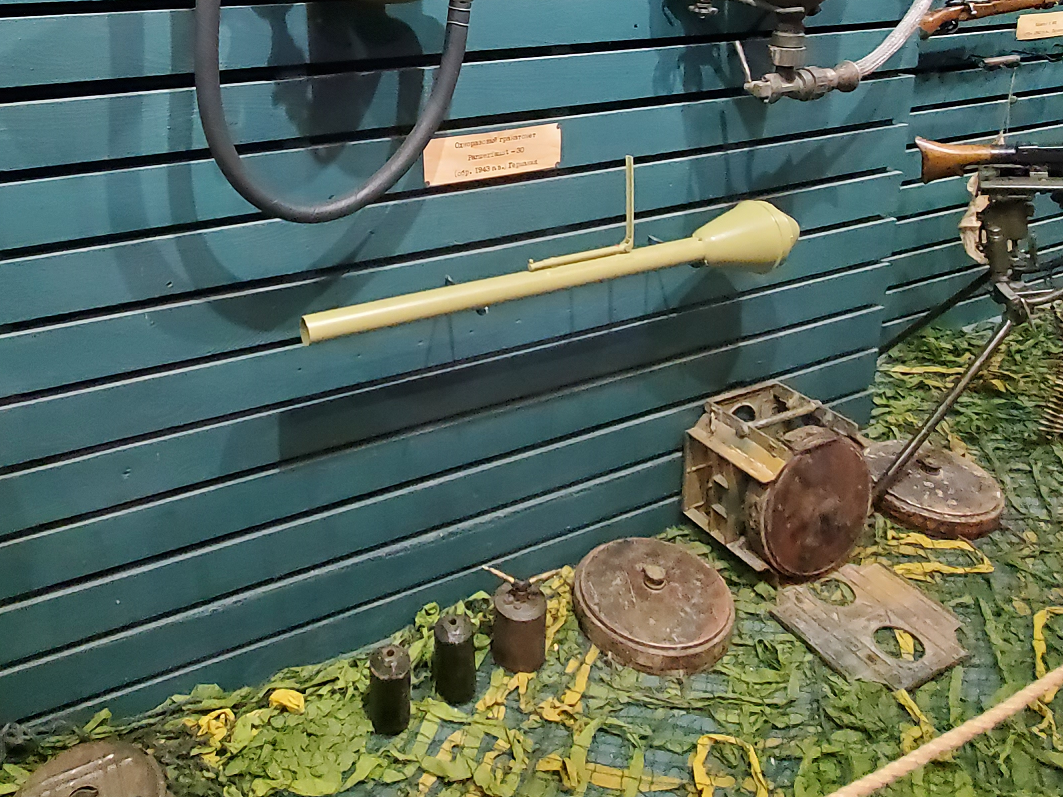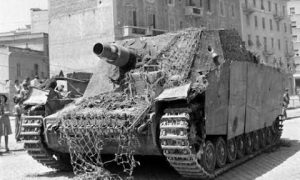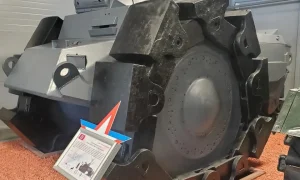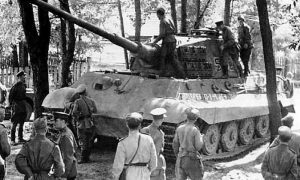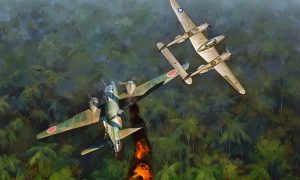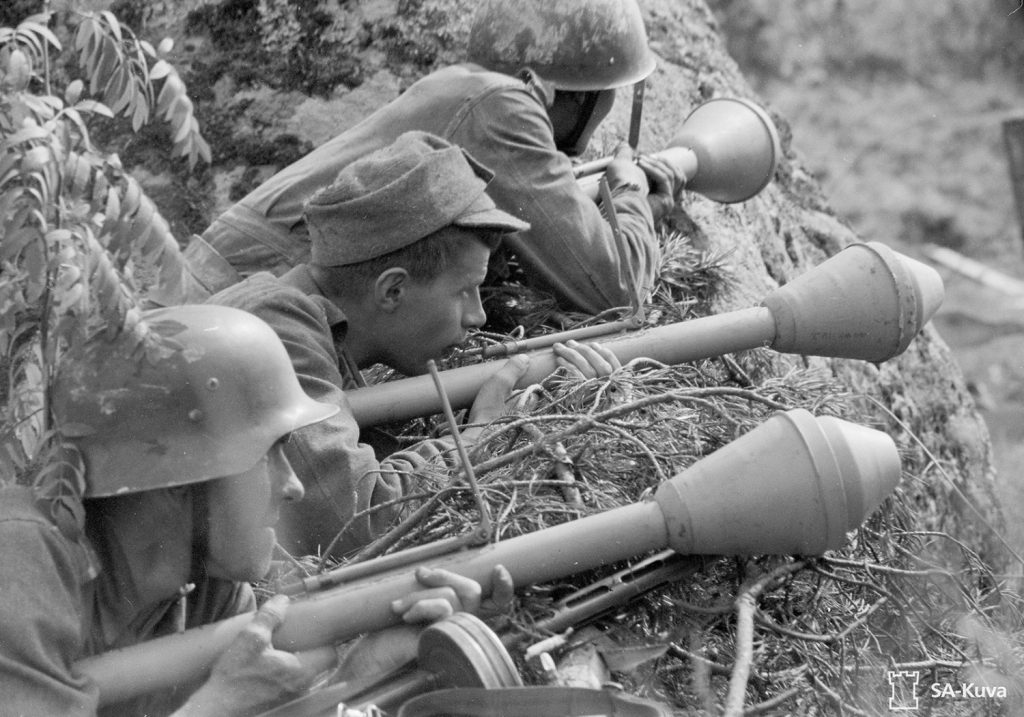 “Panzerfaust” (German: Panzerfaust, “Armored Fist”) is a German disposable grenade launcher of the Second World War. The change in the original name from “Faustpatron” to “Panzerfaust” occurred in connection with the appearance of the Luftfaust anti-aircraft grenade launcher project (prototype of MANPADS).
“Panzerfaust” (German: Panzerfaust, “Armored Fist”) is a German disposable grenade launcher of the Second World War. The change in the original name from “Faustpatron” to “Panzerfaust” occurred in connection with the appearance of the Luftfaust anti-aircraft grenade launcher project (prototype of MANPADS).
A recoilless handgun firing a grenade with a cumulative warhead was developed by the designers of the Leipzig company HASAG – Hugo Schneider AG (Hugo Schneider AG). Unlike the “Ofenror” and “Panzsershrek”, the anti-tank grenade did not have a starter rocket engine: the “Panzerfaust” was based on the dynamo-reactive principle, that is, the entire accelerating powder charge burned out in the pipe before the grenade took off, similarly to the “Bazooka M1” and “Faustpatron” (however, there were experimental samples of an anti-personnel missile for the panzerfaust). The work was supervised by Dr. Heinrich Langweiler (German: Heinrich Langweiler). Depending on the version of the Faustpatron (warhead caliber), its cumulative grenade penetrated a steel armor plate with a thickness of 140 to 200 mm, and the grenade of the Panzerfaust-150M, which never entered service, pierced a steel plate with a thickness of 280-320 mm.
Development and application


Panzerfaust is a steel pipe with a caliber of 5 cm and a length of 1 meter. On top was a sight and a starter. Aiming was carried out by combining the sight and the upper edge of the warhead. Inside the pipe was placed a charge of smoky hunting powder in a cardboard cap. In the first versions of the Panzerfaust, a propellant charge was placed into the pipe by soldiers before firing. He also equipped the grenade with a separately supplied fuse. Ahead was a warhead with a caliber of 15 cm, weighing up to 3 kg and containing 0.8 kg of explosive. The explosive was a heterogeneous “alloy” of RDX powder in TNT. It is impossible to obtain a real alloy of these substances – hexogen heated to the melting point decomposes, therefore hexogen powder was added to the TNT melt and stirred, cooled. The stability of the flight path of the mine was provided by a flexible stabilizer of four feathers of springy steel. Before the shot, the stabilizer feathers were in the launch tube wound on a grenade shank machined from wood. When fired, due to the elasticity, the stabilizer feathers turned around and provided the projectile with a more or less stable flight. At first glance, the uncomplicated design was distinguished by enviable functionality: the elongated nose cone not only gave the mine an aerodynamic shape, when it hit the armor, it, wrinkling, reduced the likelihood of a rebound, gave time to work inertial fuse. The explosion of the projectile “out of focus” caused the appearance of a shallow recess on the armor – “witch hickey” in the front-line language.
A red inscription in German was applied to the pipe: “Achtung! Feuerstrahl! (“Attention! Fire jet!”), warning the soldiers not to stand behind the shooter. The action of the jet stream was dangerous for a person at a distance of up to 3 meters behind the rear cut of the launch tube. According to the instructions, there should be 10 meters of free space behind the shooter. Like the Faustpatron, the Panzerfaust was disposable. The grenade pierced a steel armor plate up to 200 mm thick, which was enough with a large margin to hit the most powerful tank of the anti-Hitler coalition, the IS-2, in the forehead.
In urban combat conditions, a small distance allowed the use of weapons with high (albeit later greatly exaggerated) effectiveness, which was especially noticeable in the Battle of Berlin. The simplicity of the weapon made it possible to manufacture it even in the conditions of a besieged city and immediately transfer it into the hands of the defenders. The use of panzerfaust did not require high skill for a soldier, therefore, at the end of the war, both elderly Volkssturmists and young people from the Hitler Youth easily managed it.
Many panzerfausts were supplied to Finland as anti-tank weapons against Soviet tanks.
Samples of captured “faustpatrons” (as the soldiers of the allied forces mistakenly called both panzerfausts and faustpatrons) were used by soldiers of the Soviet army, and later by the USSR military- industrial complex in the development of the first domestic RPG-2 grenade launcher.
Options
| Option | Weapon weight, kg | Mass of propellant charge, g | Head part caliber, mm | Maximum grenade speed, m/s | Effective firing range, m | Armor penetration, mm |
| Faustpatron 30 | 2.7-3.2 | 70 | one hundred | 28 | thirty | 140 |
| Panzerfaust 30 | 6.9 | 95-100 | 149 | thirty | thirty | 200 |
| Panzerfaust 60 | 8.5 | 120-134 | 149 | 45 | 60 | 200 |
| Panzerfaust 100 | 9.4 | 190-200 | 149 | 60 | one hundred | 200 |
| Panzerfaust 150 | 6.5 | one hundred | 106 | 85 | 150 | 280-320 |
Panzerfaust 30
The very first version of the weapon was the Panzerfaust 30, an experimental batch of which was released in August 1943. Index 30 in the designation of the weapon refers to the nominal effective range in meters. The mass of the fully assembled weapon was 5.1 kg. According to some reports, the first use on the Eastern Front can be attributed to November 1943.
Panzerfaust 60
This is the most common modification, the production of which began in August 1944. The firing distance has been increased to 60 meters, for which the diameter of the launch tube has been increased from 44 to 50 mm, and the mass of the propellant charge has been increased to 134 g. The firing mechanism has also been improved. The weight of the weapon has increased to 6.1 kg.
Panzerfaust 100
This is the last mass modification of weapons that has been received by the troops since November 1944. The nominal firing range has been increased to 100 meters. The pipe diameter has been increased again to 60 mm. The sight has holes with luminescent marks at 30, 60, 80 and 100 meters.
Panzerfaust 150 and 250
“Panzerfaust 150” was released in a limited series at the very end of the war. The changes affected the warhead, and the charge was divided into two parts, which increased the speed of the grenade to 85 m / s and penetration. The launch tube could be reused up to ten times.
“Panzerfaust 250” was planned for release in September 1945, but its development was never completed.
Modifications of the charging part of the panzerfaust grenade
With anti-personnel missile
One of the designs allowed it to be used as an anti-personnel weapon: the kit included a small rocket, Kleinrakete zur Infanteriebekampfung (“small rocket to destroy infantry”), warhead length 245 mm, diameter 76 mm. Several examples of this design were made, tests of which showed that the range was the same as that of rifle grenades.
With increased splinter effect
At the end of 1944, the “Panzerfaust 150” used ammunition with “shrapnel rings” (Splitterringe), which had notches, like hand grenades, to increase the fragmentation effect. Such a grenade simultaneously hit both the tank and the enemy infantry, often located on the armor.
“Shrapnel Fist”
Another development was the Schrappnellfaust (“shrapnel fist”), unlike the Panzerfaust, it was rechargeable, also designed to defeat infantry. The Shrapnel Fist weighed 8 kg and had a maximum range of 400 meters.
“Improved Armor Fist”
In January 1945, a new warhead was developed for the Panzerfaust called the Verbesserte Panzerfaust (“improved armored fist”). This modification had a tube diameter of 160 mm with variable detonation distance. There is no data on the use of this variant by the Wehrmacht.
With an easy-to-manufacture charge
In February 1945, a shaped charge was developed from explosives, called “nipolite”. The manufacture of such a charge was greatly simplified, because it did not require a metal case, it was possible to grind a warhead directly on a lathe. The production of this modification of the panzerfaust was not started due to the end of the war.
During the Cold War, a fundamentally new rocket-propelled grenade launcher called “Panzerfaust 3” was developed and used for the Bundeswehr.
Assessment of Soviet specialists and military leaders
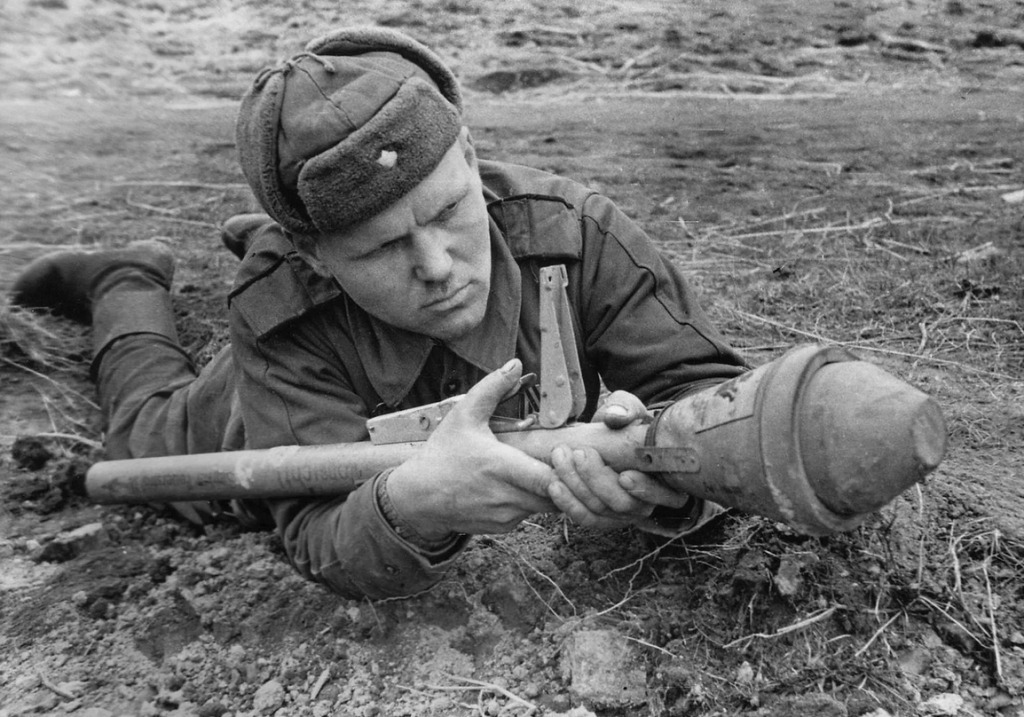


I cannot fail to note such a regrettable fact that our troops were rather poorly provided with such, for example, weapons as the Germans had a Faustpatron. But he has proven himself well in anti-tank combat. There were no active supporters of such means of struggle as the faustpatron in the GAU. It was believed that since even a 50-mm mortar is not popular among the troops due to its short range, then why, they say, create some other melee weapon along with the PTR. In addition, they say, there are anti-tank grenades.
– From the memoirs of N. D. Yakovlev, in the 1940s, the head of the Main Artillery Directorate of the NPO KA, Marshal of Artillery
I cannot agree that the faustpatron was an obstacle for tank troops. I believe that this is a reassessment of the faustpatron in the Berlin operation. Why? The Faustpatron was in the hands of an untrained, morally, physically and militarily untrained soldier of the German Volkssturm army, and therefore it was not such a formidable weapon for our unsurpassed Soviet T-34 tank. During the offensive, I talked very seriously with my corps commanders, brigade commanders, personnel and found out that the faustpatron was a bogey man, which sometimes groups or individual tanks were afraid of, but I repeat that in the Berlin operation the faustpatron was not such a terrible weapon as some others.
– S. I. Bogdanov, Marshal of the Armored Forces, Commander of the 2nd Guards Tank Army
Once again, I want to especially emphasize at this conference the great role played by the enemy’s weapons – these are faustpatrons. 8th Guards the army, fighters and commanders, were in love with these faustpatrons, stole them from each other and successfully used them – effectively. If not a Faustpatron, then let’s call him Ivan Patron, if only we had him as soon as possible.
– From the speech of the commander of the 8th Guards Army, Colonel-General V.I. Chuikov


